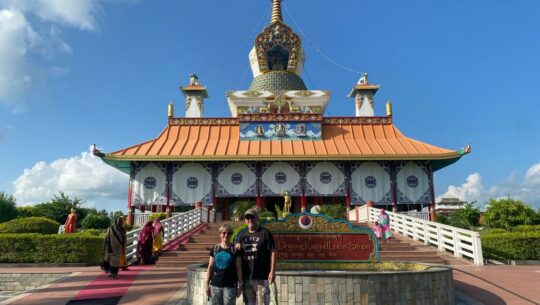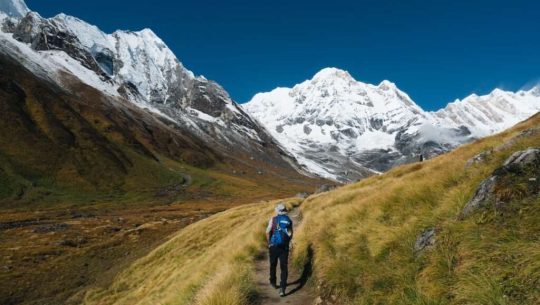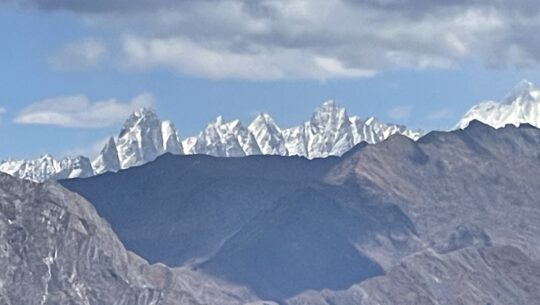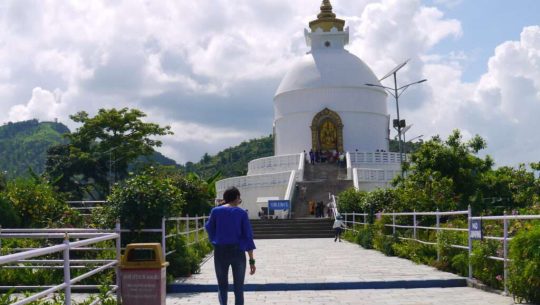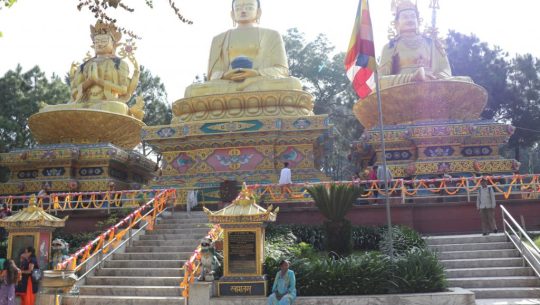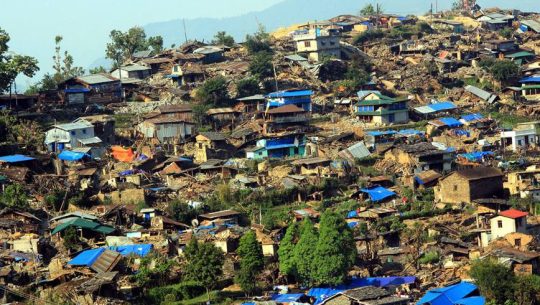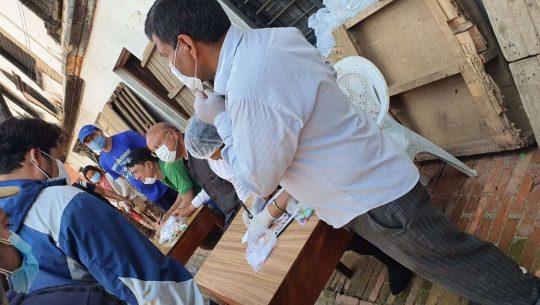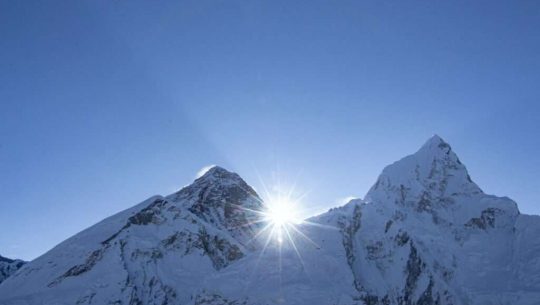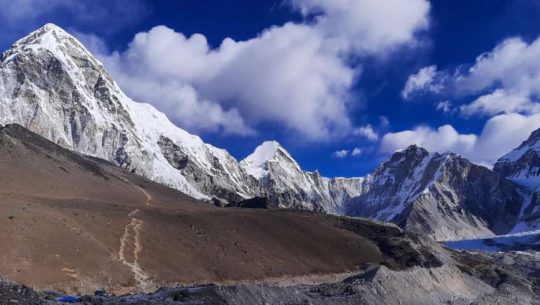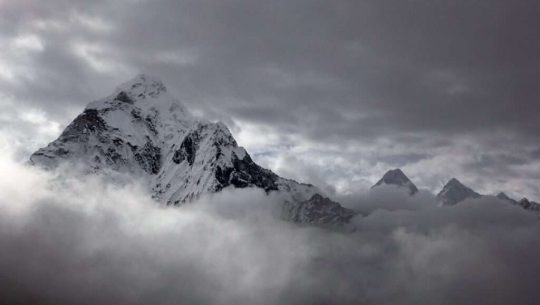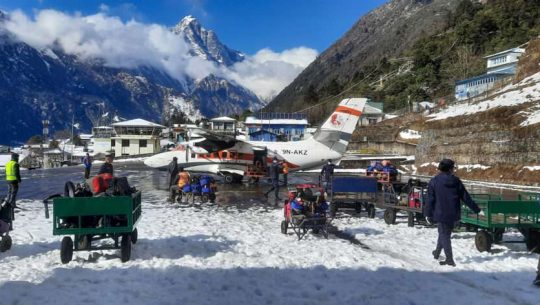Lumbini lies in the southern Terai plains of Nepal and is about 300 kilometers Southwest of Kathmandu. Lumbini Spiritual Tour is a visit to the birthplace of Siddhartha Gautam Buddha and is therefore regarded as a sacred pilgrimage site for Buddhists. The Indian emperor Ashoka visited Lumbini in 249 BC, leaving behind an inscribed sandstone pillar to commemorate the occasion. After being lost for centuries, Ashoka’s pillar was rediscovered by the governor of Palpa, Khadga Shumsher Rana, in 1896. The United Nations Development Programme contributed nearly one million dollars for the preparation of a Master Plan for the development of Lumbini, including numerous engineering and archaeological studies. The plan, which was completed in 1978, has as its objective to restore an area of about 7.7 sq. km, to be known as the Lumbini Garden, centering on the garden and the Ashoka Pillar, with an additional area of 64.5 sq. km to be developed in its support. Within the plan for the development of Lumbini Garden, there are three main components:
Three main components at Lumbini
The Sacred Garden
The Sacred Garden is the epicenter of the Master Plan and comprises the sacred birthplace of Lord Sakyamuni Buddha. Historical monuments and objects of high archaeological, religious, and spiritual value located in this zone include the Mayadevi Temple, the Asoka Pillar, the Marker Stone, the Nativity Sculpture, Sacred Pond (Puskarini), and many structural ruins including Buddhist Viharas & Stupas. The Sacred Garden landscape is encircled by a Circular Pond and a Circular Levee, which symbolize the purity and simplicity of the mandala, a mystic symbol of the universe.
The Monastic Zone
The Monastic Zone, an area of 1 sq. mile in the middle of the Master Plan has been divided into two zones by a 1. 6km long pedestrian walkways and a canal in the middle.
East Monastic Zone: The East Monastic Zone represents the Theravada (Hinayana) school of Buddhism where 13 plots are allotted for the construction of Viharas.
West Monastic Zone: The West Monastic Zone comprises 29 plots of land, each allotted for the construction of Mahayana monasteries. Currently, there are three meditation centers in operation in this zone. The statue of the standing Baby Buddha, Central Canal and its boating facility, the Eternal Peace Flame, the Peace Bell, etc. in the monastic zone are of great interest to the visitors.
The Cultural Center and New Lumbini Village
The Cultural Center and New Lumbini Village represent “worldly” activities and provide information, accommodation, and utility facilities for pilgrims and visitors. Hotels, visitor information centers, Lumbini Museum, Lumbini International Research Institute (LIRI), administration complexes, etc. are located here. Other important sites of visitors’ interest in New Lumbini Village include the World Peace Pagoda of Japan and the Lumbini Crane Sanctuary.
After the formation of the Lumbini Development Trust (LDT) in 1985 AD, development activities in Lumbini including excavations and conservations of the holy complex are being carried out under the aegis of the Trust. Development of Lumbini in line with the approved Lumbini Development Master Plan is still going on.
Monuments at Lumbini
Maya Devi Temple
The Mayadevi Temple is the heart of Lumbini and GLBC. It houses the Marker Stone, the Nativity Sculpture, and the structural ruins, all related to the birth of Lord Sakyamuni Buddha. The Marker Stone pinpoints the exact birth spot and the Nativity Sculpture depicts the birth scene of Prince Siddhartha.
Archaeological excavations have revealed that the structural ruins belong to the different phases of Mayadevi Temple’s constructions and restorations over the centuries. Emperor Asoka during his visit to Lumbini in 249 century BC, built a platform using the burnt bricks to safeguard the Marker Stone and the Nativity Tree under which Mayadevi had given birth to Prince Siddhartha. The Mayadevi Temple was re-discovered in 1896 by General Khadga Shamsher and Dr. Anton Fuhrer who identified Lumbini as the birthplace of Lord Sakyamuni Buddha concerning the Asoka Pillar. Later, Keshar Shumsher excavated the mound of the early Mayadevi Temple and reconstructed it in 1939. The present-day Mayadevi Temple was rebuilt in 2003 by the Lumbini Development Trust.
The structural ruins inside Mayadevi Temple belong to the 6th century BC to the 15th century AD. It consists of 15 box chambers arranged in 5 rows in east-west and 3 rows in north-south direction as well as a circumambulatory path surrounded by an outer wall. The archaeological excavation undertaken by the Department of Archaeology, Lumbini Development Trust, and Durham University (UK) during 2010-2013 AD uncovered a timber shrine dating back to the 6th century BC. During the excavation, a pre-Mauryan brick structure, each brick measuring 49×36×7 cm in size and 20kg in weight from underneath the present visible layers of ruins was also uncovered. These evidences suggest that the first Mayadevi Temple was built immediately after the Mahaparinirvana of Lord Sakyamuni Buddha in Lumbini which witnessed various restorations and reconstructions over the major historical periods.
The Marker Stone: The Marker Stone marks the exact location of the birth spot of Prince Siddhartha in Lumbini. The meticulous excavation of the Mayadevi Temple i) The Marker Stone ii) The Nativity Sculpture iii) Structural ruins inside the Mayadevi temple 39 (1992-1996) discovered the Marker Stone on the top of a platform consisting of seven layers of bricks from the 3rd century BC. Chinese traveler Hsuan Tsang (636 AD) describes the existence of the Marker Stone 25 steps to the north of the sacred pond. It is a sandstone-based conglomerate measuring 70 cm x 40 cm x 10 cm in size.
The Nativity Sculpture: The Nativity Sculpture depicts the birth scene of Prince Siddhartha. Mayadevi is depicted holding a branch of a tree (possibly the sal tree) as Prajapati Gautami supports her during the delivery. The newly born baby is shown below standing on a lotus pedestal. Two celestial figures (Brahma and Indra), are receiving the newly born Prince Siddhartha. The red sandstone sculpture is said to have been carved by the Mathura School of Art in the 4th century. The scientific excavation by P. C. Mukherji in 1899 AD discovered the main part of the Nativity Sculpture.
Ashoka Pillar
The Asoka Pillar was erected here in Lumbini by Emperor Asoka in 249 BC to mark the birthplace of Lord Sakyamuni Buddha and to commemorate his visit to Lumbini. The Asoka inscription engraved in Brahmi script and Pali language attests Lumbini to be the birthplace of Lord Sakyamuni Buddha. The Asoka Pillar bears the first epigraphic evidence concerning the birthplace of Lord Sakyamuni Buddha. The text is written in Brahmi script and Pali language.
The erection of this Pillar in Lumbini by Emperor Asoka was also described by early Chinese travelers including Hiuen Tsang (636 AD) and Fa-hsien (399-413 AD). In 1312 AD, Ripu Malla, the king 40 of western Nepal paid homage to Lumbini and engraved the following words: Om Mani Padme Hum Ripu Malla Chiran Jayatu on the eastern side of the upper part of the pillar.
The pillar, which was lost in the bush after the visit of Ripu Malla was rediscovered by Dr. A. A. Fuhrer and General Khadga Shumsher JBR during the excavation carried out on December 1, 1896. The pillar is a conglomerate made up of sandstone and sedimentary rock. The excavation work by Indian archaeologist Mrs. Debala Mitra confirmed that the pillar has a Mauryan polish typical of finished stone from a quarry in the neighborhood of Chunar (near Varanasi, U. P. India). The pillar when first erected was about 40 feet long and originally had three parts: (i) the monolithic pillar, (ii) a lotus bracket, and (iii) a crowning figure, which was possibly a horse. The present monolithic pillar is 30 feet 10.5 inches (9.41m) long. The middle part of the pillar ‘lotus bracket’ is recently placed on a raised brick platform near the pillar. As mentioned by Hiuen Tsang, the crowning part of the pillar was a horse image, which unfortunately is still missing.
Sacred Pond
Located 25 paces southwest of the Marker Stone is the Sacred Pond, popularly known as Puskarini, where Mayadevi is believed to have a bath before giving birth to Prince Siddhartha. The infant prince was also given the first purification bath here.
41 Early Chinese travelers Fa-Hsien (399- 413 AD) and Hiuen Tsang (636 AD) on their travel accounts also describe the Sacred Pond and the holy bath of the newly born Prince Siddhartha at this pond.
The pond existed before the birth of Prince Siddhartha, probably in an oval shape. It was remodeled in shape and size, with an embankment of bricks, during 1933-1939 AD excavations by Keshar Shumsher JBR. The present-day pond measures 24.90m × 24.85m × 4.83m in size. While cleaning the pond in 1996, two wells were found in the northeast and southwest corners of the pond. The Sacred Pond was also mentioned and described by the archaeologists Mrs. D. Mitra in 1972 and Mr. B. K. Rijal in 1983 in their excavation report.
The Stupas
The Mayadevi Shrine is surrounded by several groups of stupas. So far, 31 stupas representing 3 different categories have been excavated at the Sacred Garden of Lumbini. Of them, 29 are Votive Stupas, 1 Relic Stupa, and 1 Dhamma Stupa. The large number of ancient stupas in the vicinity signifies the importance of Lumbini as one of the holiest sites of pilgrimage after the Mahaparinirvana of Lord Sakyamuni Buddha.
The stupas were constructed here from the 3rd century BC until the 8th or 9th century AD through the Mauryan, Sunga, Kushana, and Gupta periods. Stupas erected at Lumbini Sacred Garden are of different types, designs, and styles, primarily having square, rectangular, and circular bases. Following are the stupas uncovered in the Sacred Garden.
Big Square Stupa: This stupa was constructed during the Sunga period (2nd century BC). However, archaeologist T. N. Mishra estimates it to be of Asoka time (3rd century BC).
Big Square Stupa (Dhamma Stupa): This Stupa is identified as only one Dhamma Stupa out of 31 stupas excavated so far in the Sacred Garden of Lumbini. This stupa, as 42 described by archaeologist Mishra, is believed to be of the Mauryan period (3rd century BC) which is plain in design and has a four-stepping basement. Other stupas, both having circular and square bases, are believed to have been constructed during Sunga period (2nd Century BC) and Kusana period (1st to 2nd century AD). 19 Terra-cotta seals contained in the stupa ascertain it to be a Dhamma Stupa where pilgrims and followers worship to pay homage to the teachings of Lord Sakyamuni Buddha.
Relic Stupa (Saririka Stupa): This is the only Relic Stupa out of 31 stupas excavated so far in the Sacred Garden of Lumbini. This stupa was first traced in 1975 and reconstructed above ground with Mauryan brickbats available at the site. The floor of this stupa at the time of excavation contained only the lid of a Gold Casket of cylindrical type in association with some charred human bones and other ritual offerings. The brickbats available at the site indicate the construction of the stupa during the Mauryan period (3rd century BC).
Group of Sixteen Stupas: This group of 16 Stupas belongs to Votive Stupa which was constructed during the Gupta period (7th or 8th century). These stupas were found by archaeologists D. Mitra in 1957 and reconstructed to their original shape during the 1976-77 excavations.
The row of Six Stupas: Located in the north and northeast of the Mayadevi Temple, the row of Six Stupas was constructed during the Mauryan and Sunga periods (3rd to 2nd century BC). These were also found by archaeologists D. Mitra in 1957 and reconstructed to their original shape in 1976- 77 AD.
Group of Stupas: This Group of Stupas was constructed during the 1st century BC to 5th century AD through the Kushan to Gupta periods. This Group of Stupas as noticed by T. N. Mishra, include the Stupa No. 12 to Stupa No. 29.
Monastery Complex
Two groups of monasteries have been excavated so far at the southern and southeastern part of the Mayadevi Temple in the Sacred Garden. Construction of these monasteries started in the 3rd century BC and continued until the 9th century AD through the Mauryan, Kushana, and Gupta periods. Overlapped and crowded, these structures are evidence of people’s eagerness to be laid near the sacred birth spot of Lord Sakyamuni Buddha.
Monastery Group A (East): This group of Monasteries was a residential block containing living rooms for monks, a meeting hall, two brick stupas (one square and the other circular), and a well in the courtyard of the Vihara. This group of monasteries was constructed from the 2nd century BC to the 2nd century AD through the Sunga and Kusana periods.
Monastery Group B (West): This group of monasteries consists of two groups located at the southeast of the Mayadevi Temple, altogether containing 31 rooms. This group of monasteries was initially constructed during the Mauryan period (3rd century BC) and reconstructed during the Kusana (1st to 2nd century AD) and Gupta (4th century AD) periods. Monasteries belonging to sub-group 1 (east) consist of living rooms in four directions, a meditation block in the center, and a verandah at the western side whereas sub-group 2 (west) consists of two water storage tanks and a small room (possibly a kitchen).
Eternal Flame
Located at the southern end of the canal, the Eternal Flame was created in 1986 to commemorate the International Year of Peace. It symbolises the undying effort to create peace and harmony in the world.
World Peace Pagoda
At the northernmost part of the Lumbini Garden and Monastic Zone stands the World Peace Pagoda, built by Japanese Buddhists as a symbol of unity for humanity. This enormous pagoda, dazzling bright white in the sun, often attracts locals who come to peacefully picnic in the surrounding park. Visitors can climb the stairs and walk around the upper level of the pagoda.
The Japan Peace Stupa, also known as the World Peace Pagoda, is a symbol of peace and a prominent tourist attraction in Lumbini. Completed in the early 21st century, this impressive stupa showcases traditional pagoda-style architecture. Constructed by Japanese Buddhists for $1 million, the structure features a gleaming white exterior and a golden statue of Buddha.
There is no entry fee to visit this site. Located outside the main compound but easily accessible by bike, the World Peace Pagoda includes a shining golden statue depicting Buddha in the posture he assumed at birth. Near the base of the stupa is the grave of a Japanese monk who was tragically murdered by anti-Buddhist extremists during the monument’s construction.
Robinson Crusoe Holidays offers a wide range of travel and tourism activities in Nepal, catering to various interests such as adventure, culture, spirituality, and relaxation. Here are some of the notable activities and tours they provide:
Multi-day Tour
Yoga Tour in Nepal Brief Insight
Yoga physical is a mental and spiritual practice or discipline which originated in ancient Nepal. Yoga is one of the six Astika (orthodox) schools of Hindu philosophical traditions. Yoga Tour in Nepal is a great experience in the Himalayas.
Outline Itinerary
- Day 1: Arrive in Kathmandu or your Destination
- Day 2: Visit Buddhanilkanth, Kapan and Bauddha Nath
- Day 3: Visit Namobuddha, Panauti and Bhaktapur
- Day 4: Visit Chovar, Pharping, Kirtipur and Swyambhu
- Day 5: Drive from Kathmandu to Pokhara and explore
- Day 6: Explore Pokhara then Drive from Pokhara to Kade and hike to Australian Camp
- Day 7: Trek from the Australian camp to Sarankot via Kaski Kot
- Day 8: Sarankot to Pokhara then back to Kathmandu
- Day 9: Final departure

